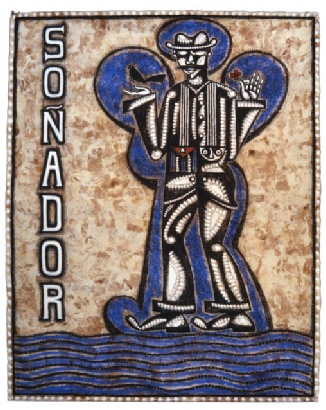

Carlos Luna: An Island for the Road
By Jesús Rosado ©
 “Art is an epiphany in a coffee cup.”
“Art is an epiphany in a coffee cup.”
- Elizabeth Murray
Carlos Luna’s visual harvest abounds in exceptional qualities. First and foremost among these is his conscious decision to paint, at the very height of postmodernism, in the same purist spirit with which Elizabeth Murray [1] audaciously set out to paint back in the 1980s. He has turned his back neither on the present nor on innovation, and indeed has taken into account that the visual arts today are a complex mesh of techniques and formal elements. Luna’s creativeness has delved into sculpture, ceramics and artifacts; yet his loyalty to the traditional format of each of these art forms has curbed any temptation to integrate them.
Another characteristic of Luna’s work is the polished convergence he achieves between aesthetic erudition –implicit in his visual expression-
The graceful candidness of his drawing technique and the rustic arrangement of figures so typical of his compositions can transport the viewer simultaneously to the animation of marionettes in traditional puppet theater; the scenes wrought by early 20th century Russian folklorists; and the captivating trajectory of American outsiders like Bill Traylor, Martin Ramírez and Eddie Arning. This is, indeed, a curious hodgepodge of inspiration, and Luna admits to borrowing elements from each when in the process of composing a piece.
When it comes to making its selections, however, the mind of this artist delves into a wider spectrum through subconscious synchronies or premeditated encounters with the transcendent legacies of universal culture. This explains his tangential brush with the formalities of Egyptian art, with two-
Other influences that Luna has dexterously assimilated into many of his works stem from Henri Rousseau’s exotic fantasies –evident in Luna’s Buen Día (2005) and Elefantito ja…bonito, bonito (2004) -
The inspirational referents outlined above in no way detract from the singular quality of Carlos Luna’s painting. His style cannot be copied: it is simply overwhelming. Every element he may borrow from multicultural sources dissolves in his vigorous Caribbean creativity and in the visual chronicle traditions found in the Spanish American world. In addition, Carlos Luna’s work is a reflection of the artist as protagonist or as repository of a visual narrative. It is personal intellectual baggage that hides in his pictorial language, a language as authentic as it is decipherable, as innovative as it is impeccably crafted. His humble rural origin, his love of the land and small-
Luna was born in 1969 in Cuba’s westernmost province, Pinar del Río. He started formal art education at the School of Fine Arts right there in Pinar del Río, and went on to Havana’s prestigious Academia San Alejandro and Cubanacán National Art School. He graduated from the Institute of Visual Arts – Cuba’s institution of higher education in the arts-
During the decade before Luna emerged as a rising talent in Cuba’s art world, the two most significant developments in the arts of the island had been a surge of extreme hyper realism, and the strengthening of a movement versed in vernacular traditions in painting that achieved notable aesthetic value. With their bold and colorful imagery, rudimentary painters like Jay Matamoros, Gilberto de la Nuez and Benito Ortiz, among others, breathed life into a Cuban reality marked by decadent political art at the service of Castro’s dictatorship. The vernacular alternative chosen by their predecessors was keenly observed and reassessed later on by the Eighties Generation. “Generación de los ‘80” was responsible for a phenomenon that shook Cuba’s visual art world by radically renewing the visual cannon and incorporating unheard of concepts and approaches to art that enabled them to push their way into the island’s cultural spaces. This revitalizing movement was christened by critics and scholars alike “nuevo arte cubano”, new art of Cuba. It sprung from a spirit of protest, and along the way it contributed new theoretical and methodological options by taking on many themes and subjects that had been long forbidden by official government censorship.
With time, this generation’s heresy would become more defiant of the governments cultural hegemony. In the mid-
Carlos Luna’s poignant and impetuous temperament emerged amidst that group of irreverent artists whose creative dynamic kindled heated transformations. Their lack of prejudice and their temerity ignored every attempt on the part of the state to demonize them. The combination of bohemian attitude and cynicism impudently unveiled to the masses the evils of the dictatorship through a truly indomitable art. It is from this realm that Carlos Luna’s work comes forth.
The Cuban government’s response to the rebellious liberalism of this generation of artists was to bar it gradually from exhibition spaces –a prerogative of Cuba’s cultural authorities-
In 1991, Luna chose exile, but not the velvety kind. His break with totalitarian rule was nothing short of drastic. There would be no comings and goings for him, only painful and irrevocable uprooting. He settled in Mexico where he met his beloved Claudia. With Claudia Ramírez he set out to forge the prospects of a new and permanent family. His island –the island tucked away in his soul-
This angst notwithstanding, he adapted his anthropological language to the experience of the continent. The visual drama of his already replete iconography became further enriched by the idiosyncrasy of his new milieu. Luna never abandoned the truly vernacular themes of his native culture; instead, he infused them with the most contemporary aesthetic expression while preserving the influence of the Havana School [3] and most particularly that of Carlos Enríquez, Marcelo Pogolotti and Wifredo Lam. What is undeniable, however, is that the twelve years that Luna lived in Mexico define another stage of his creativity; one could state that there was cultural osmosis at work.
His insatiable quest for definition and meaning takes him to the Mexican muralists, particularly to the work of Rufino Tamayo, José Guadalupe Posada and Francisco Toledo. New referents join the amalgam of those already mastered. He discovers amate paper and the advantages of this hand-
Luna’s work thus acquired a mild Mexican flair that incorporated the brilliant chromatic repertory so frequently found in Mexican art, and assimilated certain referents of the local culture. This is clearly seen in the way Luna begins to represent Death, the macabre icon that Maestro Posada exorcised into a secular and festive motif, and which Luna incorporates into several of his paintings, like in Se Te Acabó El Mamey Cabrón (2003). Formally, the intensity of colors is thoughtfully subdued by Luna’s sense of equilibrium of the very values he uses to achieve the intended gradation. Luna never accommodates representation to any given stylistic transformation. One could affirm the contrary: that although the hybrid character of Luna’s intellect has widened and diversified his options of expression, each cultural “mutation”, each cross breeding with segments of extraterritorial –non-
Carlos Luna and his family settled in Miami in 2003. Coming to South Florida brought him close to his native Cuban milieu once more. It also allowed him to come in contact with the most innovative manifestations of Cuban exile art as well as the vanguard movements in American art. Relocation returns him, to a certain extent, to the coordinates of his rebellious artistic beginnings. The only difference is that this time his talent has already flourished, and the new context –with its immense potential for exploding and communicating his creative wealth-
The American period of this young artist’s work, evenly spread between the island’s proximity and the impact of cosmopolitan America’s intellectual life, has not inflicted the pangs of identity negotiation, something to which the creativity of some exiled artists has been prone. Instead, Luna’s American period has confirmed the recurring vision that art does belong to a given latitude and that his will to make Cuban visual anthropology more universal is what tunes in his inspiration and craft to the beat of periodic vanguards. These are unequivocal signs that to assume one’s roots can be an unconventional occurrence.
His colossal piece, El Gran Mambo (2006), which he conceived in Miami, sums up Luna’s career. I consider this his masterpiece. This painting is a sort of fantastic essay which pays tribute to the epic elements in the works of Pablo Picasso and Mexican master painters, as well as the wealth of symbols in Wifredo Lam, albeit from Luna’s own vision of the world. Luna’s formal and thematic journeys are integrated into this piece. El Gran Mambo is a virtual anthology of the very aspects of Luna’s work that make of him, in my opinion, the exponent most genuinely Cuban among the artists who conform the “new art of Cuba.”
There is in Carlos Luna’s work both anecdote and graphic commentary; myth and mysticism; an element of the erotic, and prejudices; religiosity and Afro Cuban fetishism; pop with Cuban national referents and irony-
The captivating result of his work is the fruit of incessant hard labor. Carlos Luna toils over each piece with feverish detail, starting with the meticulous way in which he prepares the work’s support, and how he perfects every trace during the initial stages of painting in order to define distinctly the visual effect he has chosen. Far from making a statement in itself, the surface texture is generally subdued. To accomplish this effect, the artist works long and strenuous hours at giving the canvas the terseness of stretched hide, as if shaping the surface of a drum.
To attain such great depth of color and the ornate filigrees typical of his works, Luna toils over his creation like a goldsmith, armed with brushes of all sizes, spatulas, chisels, self-
Thus pours forth an unending stream of roosters, knives, elegguas [5], plants, bulls, stars, horses, phalluses, airplanes, domestic ware and people. Graphic transposition revolves around the internal dialogue that transpires on the vernacular stage. Within its theatrical sub-
Written by Jesus Rosado, Miami, Florida, September 2006
Translation: Ileana Fuentes
[1] Elizabeth Murray (b.1940 in Chicago) is a well known American artist whose work can be easily recognized: vivid and brilliant colors; seemingly abstract shapes rich in domestic references such as coffee cups, tables and very vital human figures. Her compositions are excitingly disconcerting and imbued with suggestive narrative. She is among the most prominent artists of her generation, and she exerts aesthetic influence in contemporary art. back
[2] Lenormant, Francois (1837-
[3] The Havana School –la Escuela de La Habana-
[4] Sheets of hand-
[5] Head-




The Cisneros Capital Group (CCG) Art Collection is a private art collection represented by Latin American Art Investments Corp. (LAAIC) -
The CCG Carlos Luna Art Collection is being presented online so that more people can enjoy these great paintings. If you work for a Museum, City Cultural Center, or University Institution and are interested in an exhibition of Carlos Luna, please contact us.
Web Site Designed & Maintained by Reinfeld Web Designs.
Images copyright © 2009 -
CCG Art Collection > Carlos Luna > Article



Home l Site Map l Contact l Oil on Canvas Paintings l Works on Paper l Sculptures l Directory of Artwork l About the Collection
Carlos Luna Bio l Books l Articles About Carlos Luna l Exhibitions List l Museums & Public Collections l Sculptures in Museums
| Exhibitions List |
| Museum and Public Collections |
| Sculptures in Museums |
| Bio |
| Books |
| Articles |
| Directory of Artwork |
| Purchase Art |
| About the Collection |
| Slideshow: Oil on Canvas |
| Slideshow: Sculptures |
| Slideshow - Works on Paper |
| Contact Us |